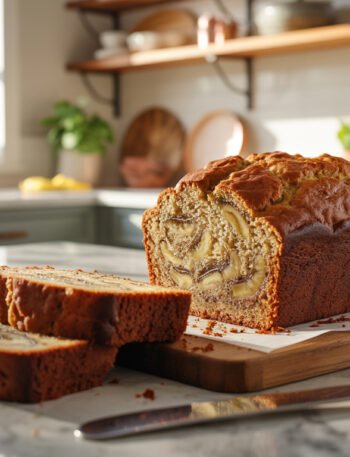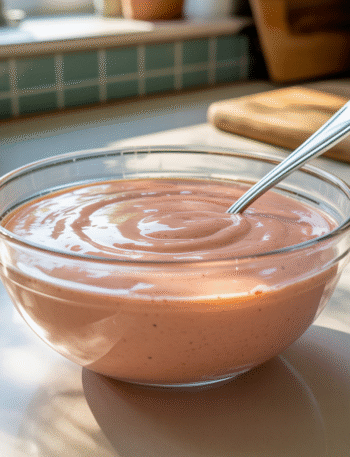
Prepared horseradish is the nose-tingling condiment that upgrades roast beef, smoked fish, Bloody Marys, and cocktail sauce. Making it at home takes about 10 minutes, costs less than store-bought, and crucially lets you control the heat. When the root is chopped, myrosinase converts glucosinolates to allyl isothiocyanate (the “heat”). Adding acid (vinegar) halts that reaction, “setting” your preferred intensity.
Safety Note
The fumes are potent. Work with cold ingredients, ventilation (window/fan), and keep hands away from eyes. Gloves help.
Ingredients
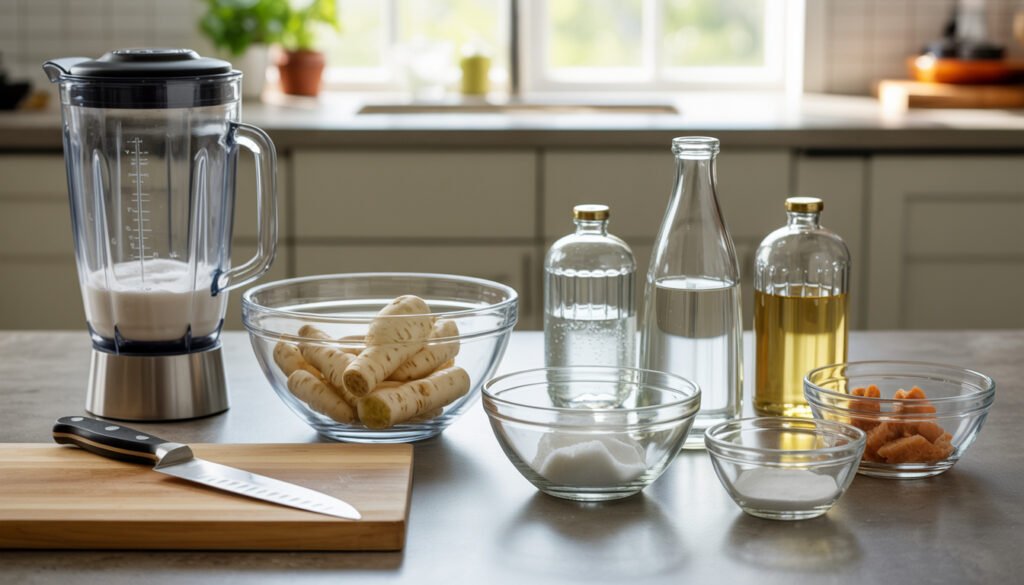
- 8 – 10 oz (225 – 280 g) fresh horseradish root, peeled and chopped
- 2 – 4 Tbsp ice-cold water (start with 2 Tbsp; add only if needed)
- ⅓ – ½ cup white distilled or apple cider vinegar (5% acidity)
- ½ tsp kosher salt (to taste)
- 1 tsp sugar (optional, rounds sharpness)
Equipment: Food processor (or fine grater/Microplane), peeler, knife, clean glass jar with tight-fitting lid. (Optional: Chill the processor bowl/blade 10 minutes to keep the mixture extra cold.)
Step-by-Step Process
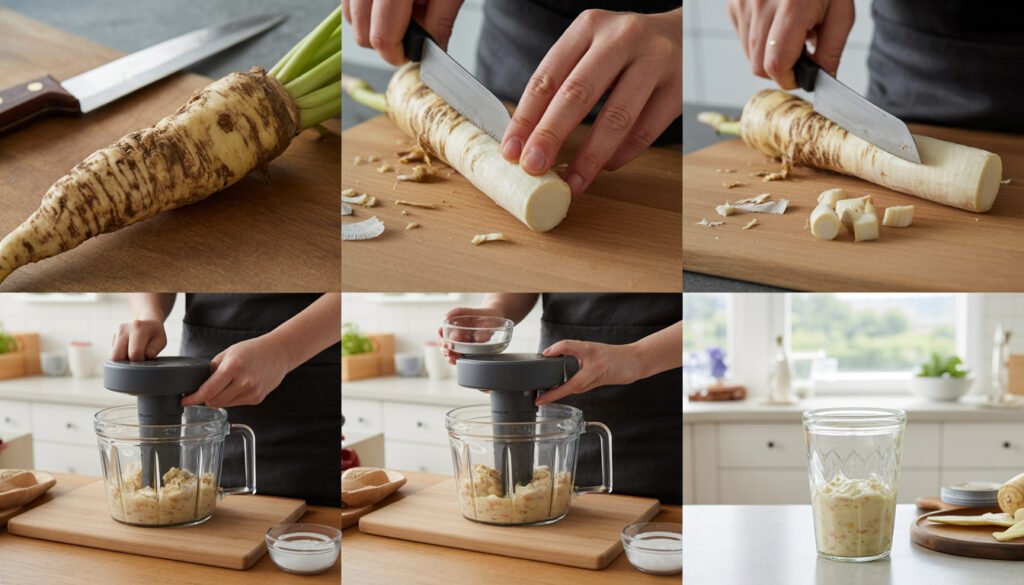
- Prep the root: Peel; trim woody bits and stringy roots; cut into ½ – inch cubes.
- Ventilate: Work near an open window or fan – volatiles peak right after chopping.
- Pulse: Add horseradish cubes + 2 Tbsp ice water to processor. Pulse until very finely chopped, scraping bowl as needed. Add up to 2 Tbsp more water only if the blade stalls.
- Control the heat:
- Mild: Add vinegar immediately to stop heat development.
- Hot: Wait 2/3 minutes (do not exceed ~3 minutes), then add vinegar for a hotter result. Waiting much longer vents aroma and may introduce slight bitterness.
- Acidify & season: Add vinegar, salt, sugar (optional). Pulse just to a loose, spoonable paste.
- Jar & chill: Pack into a clean glass jar, pressing to remove air pockets. Seal and refrigerate. Flavor is best after 12 – 24 hours.
Heat & Texture Tips
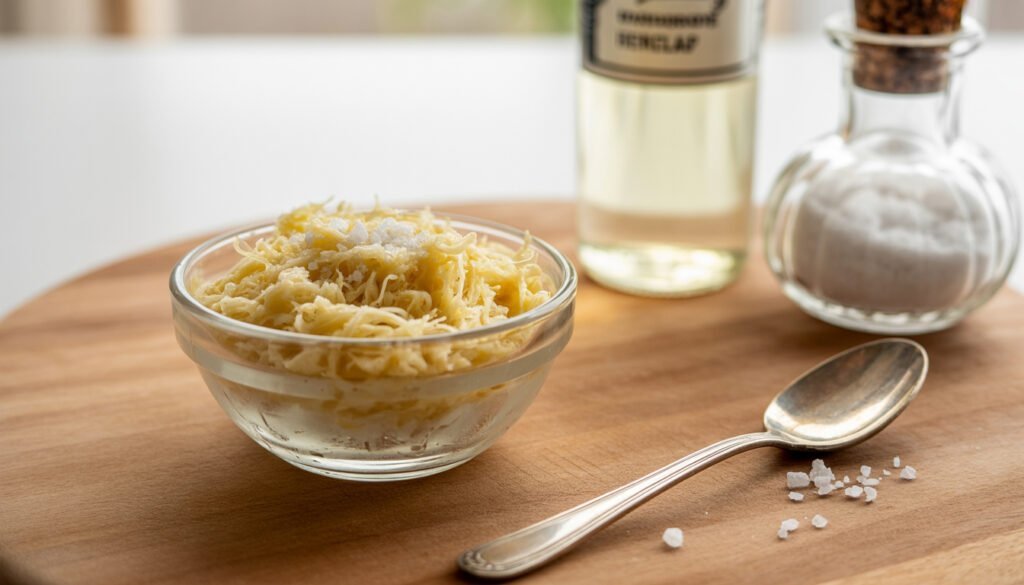
- Too mild? Next batch, wait the full 3 minutes before acidifying, and use very fresh root.
- Too hot? Stir in a splash more vinegar and a pinch of sugar.
- Too loose? Drain a teaspoon of liquid or pulse in a little more root.
Variations
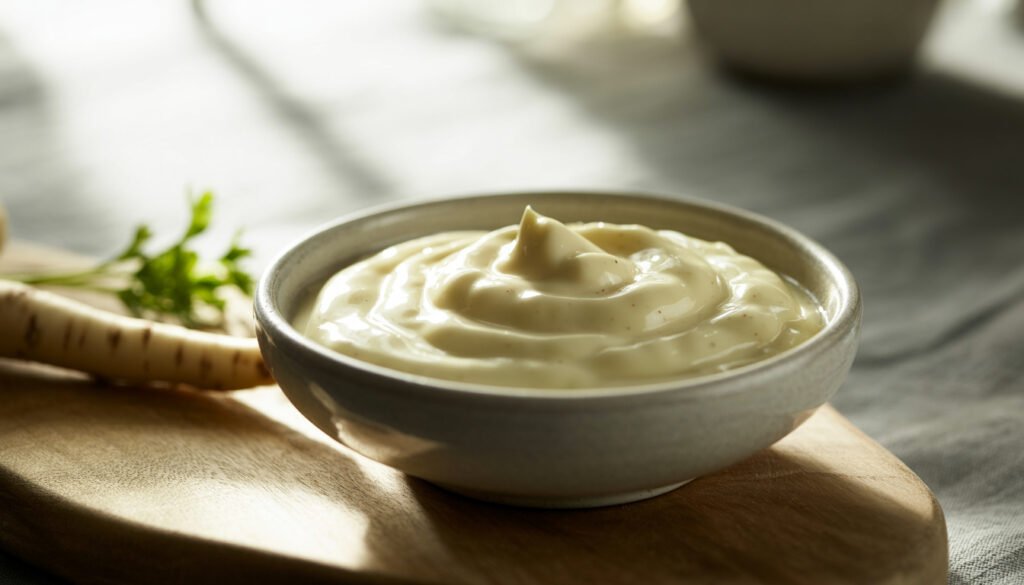
- Creamy Horseradish Sauce: Whisk ½ cup prepared horseradish, 1 Tbsp Dijon, 1/2 tsp lemon juice, pinch of salt. Chill 1 hour. Use within 5 – 7 days.
- Beet Horseradish (Chrain): Fold in ½ – 1 cup finely grated raw or cooked beets for color and sweetness – excellent with brisket or smoked fish.
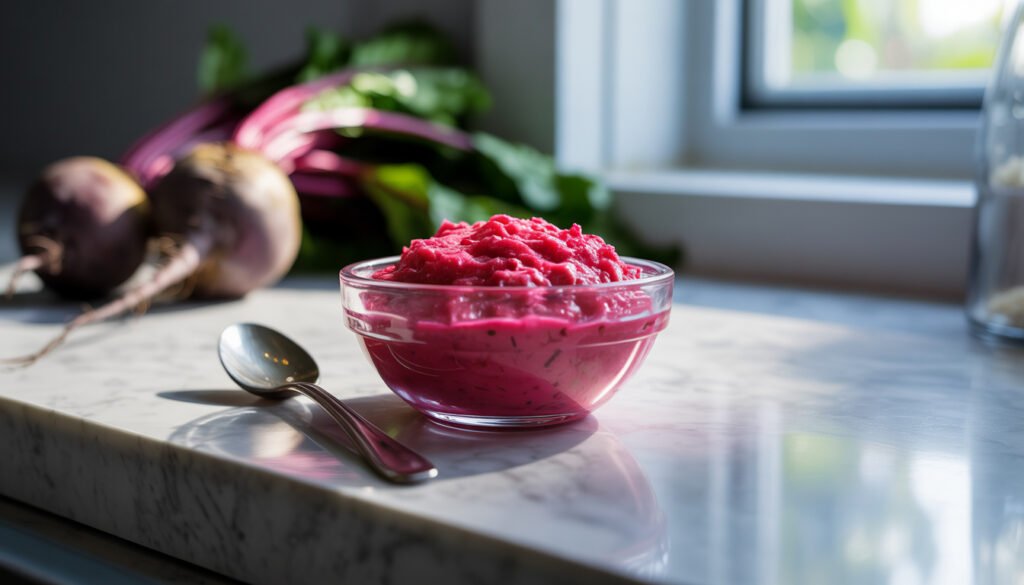
Serving Suggestions
- Smoked fish boards: lox/gravlax, capers, scallions, rye or bagels
- Roast beef & prime rib: alongside au jus
- Deviled eggs/potato salad: mix 1/2 tsp into dressing
- Shrimp cocktail sauce: ketchup + lemon + prepared horseradish
- Bloody Marys: ¼ – ½ tsp per glass
Serving size: Start with 1 Tbsp per person and adjust to taste.
Nutritional Value (approx. per 1 Tbsp)
- Calories: ~7
- Carbs: ~2 g (fiber ~0.3 g)
- Protein: ~0.1 g
- Fat: 0 g
- Sodium: ~60 – 90 mg (varies with salt)
Based on standard prepared horseradish with vinegar; actual values vary by root and seasoning.
Storage & Food Safety
- Refrigerate immediately in a glass jar; keep ≤40°F / 4°C.
- Not recommended for water-bath canning (quality and pungency degrade).
- For longer storage, freeze in small portions (expect some aroma loss and wetter texture after thawing; best stirred into sauces).
- Potency gradually wanes; highly acidified, well-chilled batches keep ~3 – 4 weeks.
Troubleshooting
- It turned brown: Air exposure. Pack tighter and keep the surface lightly covered with vinegar.
- Weak “nose hit”: Root may be old/warm or vinegar was added too soon. Next time use very fresh, well-chilled root and wait 2/3 minutes before acidifying.
- Stinging eyes: Short pulses, step back while blending, and use a fan.
Conclusion
This five ingredient, 10 minute staple puts you in full control of heat and flavor. Keep a jar in the fridge to wake up meats, seafood, salads and your weekend cocktails.
FAQs
Q1. Can I use apple cider vinegar instead of white?
Yes. White is neutral; cider adds a gentle fruity note. Keep acidity at ~5%.
Q2. Do I need a food processor?
No. A Microplane works great in small batches, then stir in vinegar/salt/sugar.
Q3. How long does it stay hot?
Peak pungency is the first 1 – 2 weeks; it softens over time. Add a fresh spoonful to perk up sauces.
Q4. Is sugar required?
Optional – just rounds sharp edges without “sweetening” the flavor.
Q5. Can I make it shelf-stable?
Home canning isn’t recommended. Refrigerate or freeze for longer storage.


